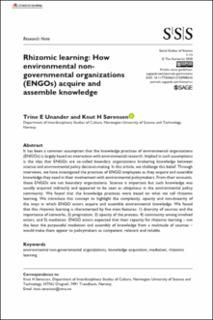| dc.contributor.author | Unander, Trine E. | |
| dc.contributor.author | Sørensen, Knut Holtan | |
| dc.date.accessioned | 2020-03-23T11:29:07Z | |
| dc.date.available | 2020-03-23T11:29:07Z | |
| dc.date.created | 2020-03-20T16:30:07Z | |
| dc.date.issued | 2020 | |
| dc.identifier.issn | 0306-3127 | |
| dc.identifier.uri | https://hdl.handle.net/11250/2648086 | |
| dc.description.abstract | It has been a common assumption that the knowledge practices of environmental organisations (ENGOs) is largely based on interaction with environmental research. Implied in such assumptions is the idea that ENGOs are so-called boundary organizations brokering knowledge between science and environmental policy decision-making. In this article, we challenge this belief. Through interviews, we have investigated the practices of ENGO employees as they acquire and assemble knowledge they need in their involvement with environmental policymakers. From their accounts, these ENGOs are not boundary organizations. Science is important but such knowledge was usually acquired indirectly and appeared to be seen as ubiquitous in the environmental policy community. We found that the knowledge practices were based on what we call rhizomic learning. We introduce this concept to highlight the complexity, opacity and non-linearity of the ways in which ENGO actors acquire and assemble environmental knowledge. We found that this rhizomic learning is characterized by five main features: 1) diversity of sources and the importance of networks, 2) pragmatism, 3) opacity of the process, 4) community among involved actors, and 5) mediation. ENGO actors expected that their capacity for rhizomic learning – not the least the purposeful mediation and assembly of knowledge from a multitude of sources – would make them appear to policymakers as competent, relevant and reliable | en_US |
| dc.language.iso | eng | en_US |
| dc.publisher | Sage Publications | en_US |
| dc.rights | Navngivelse 4.0 Internasjonal | * |
| dc.rights.uri | http://creativecommons.org/licenses/by/4.0/deed.no | * |
| dc.title | Rhizomic learning: How environmental nongovernmental organizations (ENGOs) acquire and assemble knowledge | en_US |
| dc.type | Peer reviewed | en_US |
| dc.type | Journal article | en_US |
| dc.description.version | publishedVersion | en_US |
| dc.source.journal | Social Studies of Science | en_US |
| dc.identifier.cristin | 1802709 | |
| dc.description.localcode | © Author(s) 2020. This work is distributed under the Creative Commons Attribution 4.0 License. DOI: 10.1177/0306312720908343 | en_US |
| cristin.ispublished | true | |
| cristin.fulltext | original | |
| cristin.qualitycode | 2 | |

